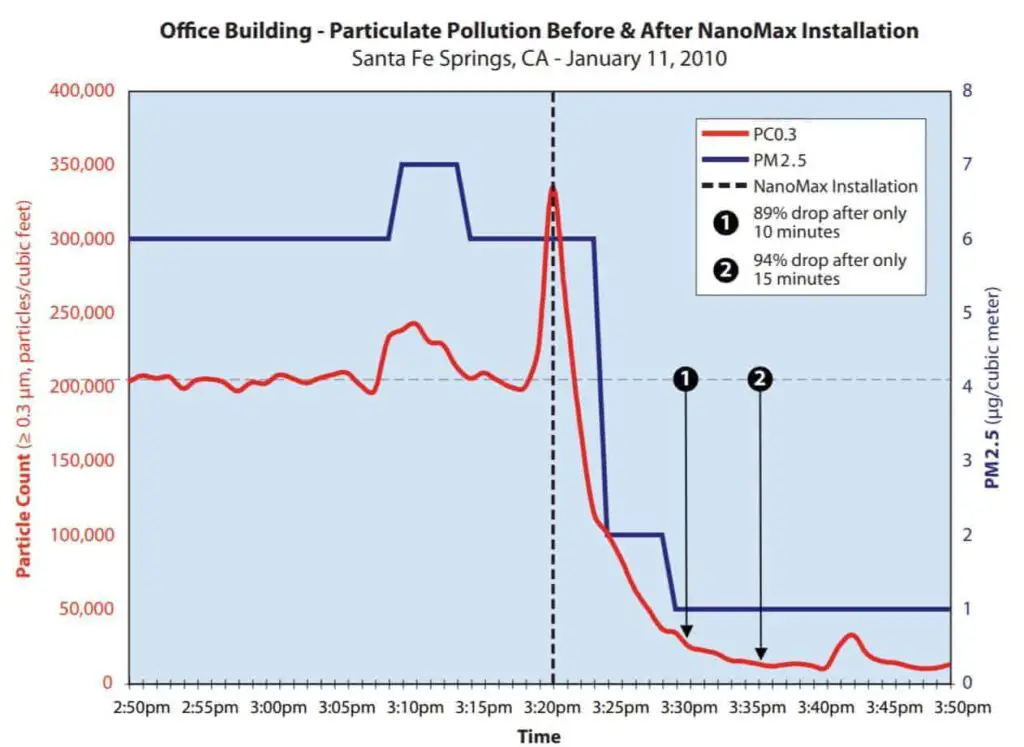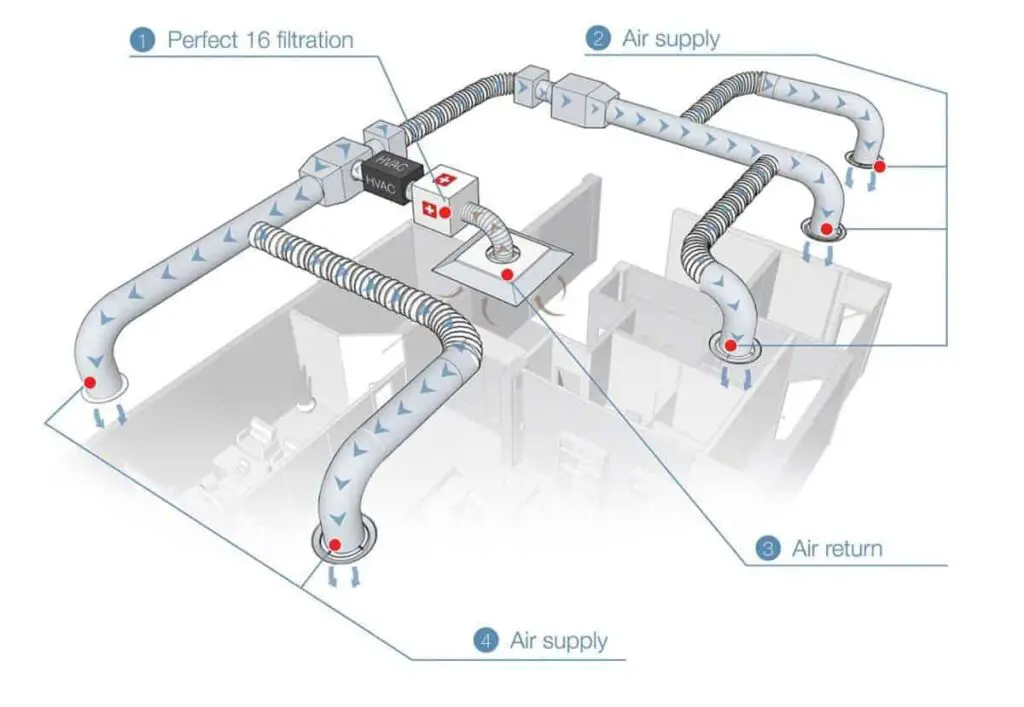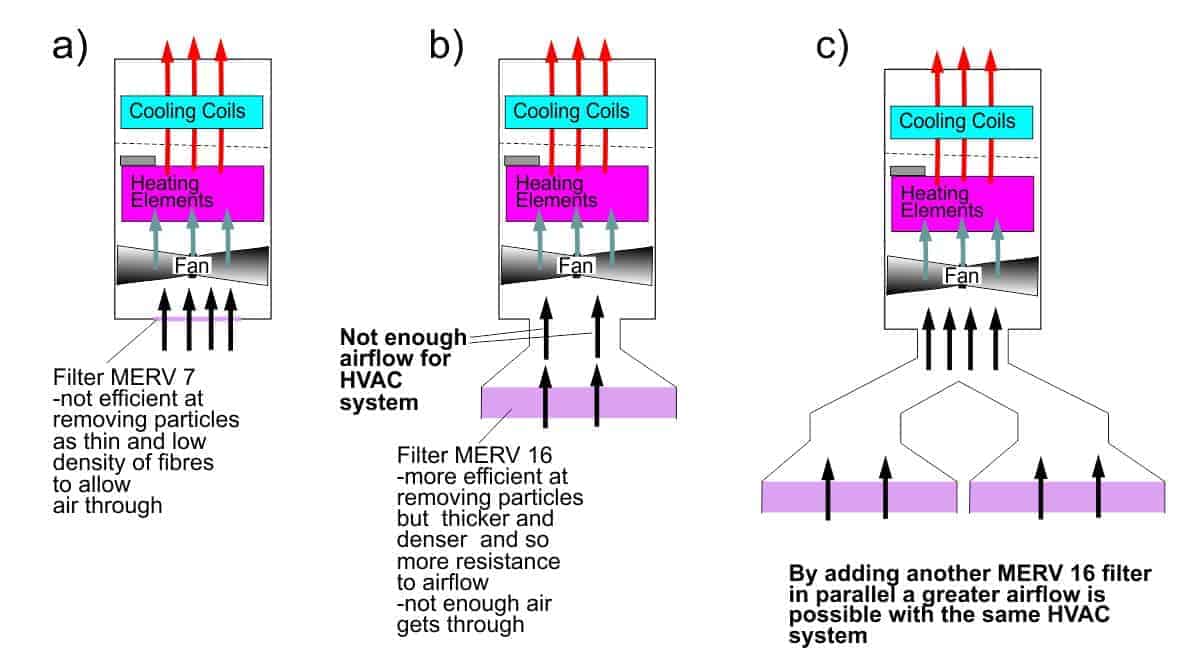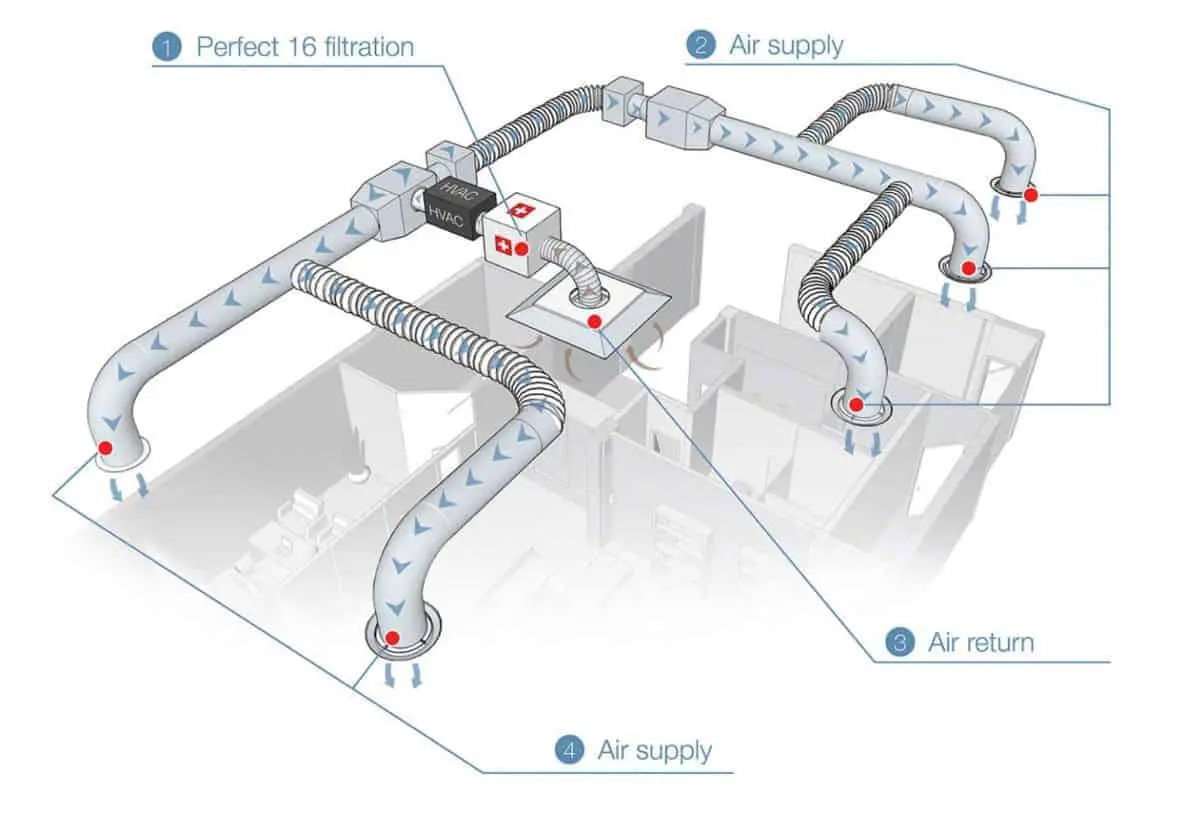Indoor air pollution is 1.5 to 3.5 times higher than outdoor pollution and in developed countries, we spend 90% of our time inside buildings. This is partly at work but also in our homes where we already have an air treatment system, an HVAC system. These systems are used to condition the temperature of the air. So it is natural to think could I also improve my indoor air quality with my HVAC system, by making it into a whole home air purifier?
As a general rule, an HVAC system’s ability to purify air can be improved with a change of filter. A MERV 16 filter should be used. This filters the air much better but increases the resistance to air flow so the system may need to be modified to cope.
The alternative is to have a portable air purifier in each room that is used by a member of the family. It will initially be cheaper to buy 5 portable air purifiers than to remodel an HVAC system, however filter replacements for 5 portable air purifiers will be much more expensive than one filter replacement for the HVAC system. So annual costs will favor a whole home air purifier, but which gives the best indoor air quality?
The main components that we need removing from the air by our whole home air purifier are fine and ultrafine airborne particles. These both have health implications and so any air filtration system must be able to remove them.
The HVAC System Must Have a High Grade Particle Filter
In an HVAC system the air returns from the rooms in the return duct and then goes to the filter, often known as the “furnace filter”. From here it goes into the air handler where the fan drives the air past the heating coils which are attached the furnace and the cooling coils which are attached to the air conditioning unit. The air then returns to the rooms.
To improve indoor air quality we need the following particles to be removed-
- House dust mite
- Pet dander
- Pollen
- Mold Spores
- Dust-household and atmospheric
- Bacteria
- Viruses
- Brake dust
- Tire dust
- Vehicle exhaust particles
- Smoke particles both cigarette and wildfire
The only way to very efficiently remove particles from the air is to have a filter made of fibrous material. Other technologies are not sufficiently effective in removing particles. This includes electrostatic, photocatalytic oxidation, ionizers, and UV light treatment of air. In general, these are not as good at removing particles from the air as filters with material in them are. Some of them will not remove any particles at all e.g. UV light treatment. An air purifier using photo electrochemical oxidation technology was found by Wirecutter not to be very efficient at all in removing particles from the air-
It is fine to add these technologies to a filter, but please bear in mind that it is the material in the filter that is the crucial element of the system.
Some of these technologies also need considerable maintenance. For instance, electrostatic filters require removing and washing every 2 to 4 weeks. However in an HVAC system an electrostatic precipitator could be placed downstream of the filter to remove some additional particles.
So we need to base our air purification around a filter made of material.
Filter Quality-HEPA or MERV?
There are two filter standards: one is HEPA (high-efficiency particulate air) and the other is the MERV (minimum efficiency reporting value) grading system. So what standard of filter should our whole home air purifier have?
HEPA filters have much higher efficiency at filtering particles out of the air than MERV rated filters. This is shown in the following diagram below of the efficiency of removal particles versus particle size. Filters all have the most difficulty in removing particles that are approximately 0.3 um in diameter. As the diagram shows a MERV 4 filter filters out very few of these particles, a MERV 8 filter filters out only approximately 25% of these particles, and a MERV 12 filter approximately 60% of these difficult particles. It is only with a MERV 16 filter that 95% of the particles this size are filtered out. Conversely, a HEPA filter will filter out 99.97% of these particles. So, a HEPA filter would ideally be used but if not then at least a Merv 16 filter.

The EPA recommends if you “decide to upgrade or use a higher efficiency filter, choose a filter with at least a minimum efficiency reporting value (MERV) 13 rating, or as higher rating as your system fan and filter slot can accommodate“.
This is excellent advice, but a MERV 13 filter will only filter out approximately 66% of particles in the size range that filters find most difficult to deal with. A MERV16 filter will remove 95% of these particles and a HEPA filter 99.97% of these particles. So there is good reason to increase the specification of the HVAC filter beyond MERV 13 if possible.
The problem is that more efficient filters required for purifying air better need thicker filter media, which obstructs airflow more. If the fan in the HVAC system is only able to pump a small amount of air around the system because of the obstruction of the fan, then it can damage the system. Low airflow in an HVAC system can allow the heating element to overheat and even crack. The element could then leak carbon monoxide into the dwelling. This can be fatal. Low airflow can also damage the cooling coils. If the airflow is not removing the condensing moisture on the coils they can ice up – and become encased in a block of ice. Then liquid condensate can flow back into the air conditioning unit and damage it.
The HVAC System Fan Needs to Run All the Time That You Are in the House
Usually the fan in an HVAC system will be off when the temperature is within the range set by the thermostat. Over the year, this can be the majority of the time. To use the HVAC system as a central air purifier, the fan will need to be running for 45 minutes before you enter the home and then all the time you or your family are in the home. Fortunately, most modern HVAC systems will allow you to leave the fan on continuously. This will cost $300-500 per year more than having the fan on auto mode.
The HVAC System Fan Needs to be Powerful Enough To Provide Required Air Flow
For good air purification, the air in the room needs to go through the filter at least five times per hour (for asthmatics eight times per hour)-EPA. A typical HVAC fan will produce 1000 cubic feet of air per minute (cfm), so this would be enough for a dwelling of about 1500 ft.² assuming ceilings are 8 foot high. This output from a typical HVAC fan is when it is using a fairly non-obstructive filter. With a thicker filter, the airflow may be much lower.
So to use your HVAC system as an air purifier you would need to know how powerful your HVAC fan is in terms of cubic feet per minute of air pumped. This will allow you to assess whether using the existing fan will be powerful enough to supply 5 air changes per hour to your entire home.
Even at a lower rate of air changes per hour there would be some effect and for instance at 2.5 air changes per hour a typical HVAC system would be able to service an area of about 3000 ft2. However the particle count would be higher than the EPA recommended 80% reduction.
So you may either need a more powerful fan, or need to settle for your HVAC whole home air purifier providing background airborne particle reduction and using air purifiers in the rooms where you spend most time to hit he EPA target.
Filter Systems That Are Efficient but Will Not Obstruct Air Flow Too Much
There are 3 solutions to the problem of the filter being efficient but not obstructing the airflow so much that the fan cannot cope with it. These are-
- a standard sized more effective filter which is as nonobstructive as possible
- a bypass system in which only some of the air goes through the high efficiency filter
- remodeling the HVAC system so that the filter is much larger
1) High Efficiency Filters Standard Sized Filters
Lennox PureAir S (MERV16)
This is the top of the range Lennox unit. It incorporates UV light and a photocatalytic carbon filter. It does not produce ozone. It needs a Lennox S30 thermostat. Installation approximately $2000 + cost of the unit. Nominal airflow capacity is 2000 cubic feet per minute, so it would be suitable for a dwelling of 3000 square feet.
Aprilair 2000 series (MERV 16)
Smaller filters in this range go up to 1600 cfm and so will service an area of 2400 square feet. There is a giant filter outlined in the next section which will need system remodelling.
iQair Nanomax (MERV 16)
Unique Nano and microfiber filter media and pleat design maximize surface area, giving 5 times the surface area of the standard pleated filter.

So this filter provides very low resistance and so virtually no reduction in HVAC airflow. So it does not put a significant strain on your HVAC system. It has special wedge-shaped seal so that air does not flow around the filter rather than through it. Custom sizes are available. In a study in schools to protect children from air pollution, AQMD approached 150 manufacturers of which 9 took part in the program. The NanoMax filter was the only HVAC mounted device that satisfied the performance requirements set by AQMD.

2) Bypass Systems
HEPA filters would provide too much resistance to airflow so that the HVAC system is damaged. So to get around this, manufacturers produce bypass systems. With these systems, some air from the return duct flows straight through the HVAC system as normal, but the rest of the air goes through the HEPA filter and then back into the return duct. As only a portion of the air goes through the HEPA filter, it greatly reduces the resistance to airflow. However, this also means that it also reduces the amount of air purified. So these systems only supply enough purified air for relatively small areas.
Lennox HEPA-60
This is the largest of the Lennox series of HVAC HEPA air filters. Even this largest model in the range would only be able to perform 3.8 air changes per hour for at home of a 1000 square feet.
Hawk Environmental AirWash Whisper HEPA Filtration System
The largest unit processes 675 cubic feet per minute so suitable for a dwelling of about 1000 square feet.
Further information regarding efficient custom HVAC filters can be found in this article.
3) Systems Providing Increased Filtration Capacity but Needing HVAC system modification.
Aprilair 2000 series (MERV 16)
The largest filter in this series, which has the lowest resistance to flow is the 2516. The highest flow for this model is 2600cfm pressure drop at this flow rate is 0.36 inches water column. At 2000 cfm the pressure drop across the filter is 0.24 inches water column. It is suitable for dwellings up to 4000 square feet.
In view of its size (31 x 28 inches) it will need some reconfiguring of HVAC system. The installation cost will depend on your system but likely to be of the order of $2000.
Filter cost per year $200* (Filter life 6 months Filter cost $100 if buy in a pack of 2) and the filter needs changing every 6 months.
The manufacturer does not specify the degree of removal of ultra-fine particles. These are particles that are so small they can enter our blood stream.
iQair Perfect 16 (MERV 16 and Removes 85% of Ultrafine Particles)
This filter is well suited to creating a whole home air purifier as it is the lowest resistance MERV 16 filter so will put less strain on your HVAC system. The pressure drop is 0.22 inches water column at 2000cfm.
Rated airflow 2000 cubic feet per minute so suitable for a dwelling up to 3000 square feet.

Installation cost $2700-$3200. Filter Cost per Year $100* (Filter cost $295 Filter life 3 years)
Filter needs changing every 3 years-so the lazy householders option.
Remember to the filter cost needs to be added to the increased cost of the electric power in keeping the fan on continuously $300.
* if you have standalone air purifiers in 3 rooms in your house, it is likely to cost you $300 per year in filters. Also $100 per year in replacement costs for the air purifiers and $100 in electricity. So running costs for separate air purifiers are likely to be in the ballpark of $500 per year.
Further details of the custom features of this HVAC filter system can be found in this post.
NB The size of dwelling calculations are per EPA guidance and assume 8 foot ceilings.
What if These HVAC Filtration Systems Do Not Seem to Filter Enough Air For the Size of Your Home?
Parallel Filtration Systems?
Why not run the systems in parallel? Logically, if you were to run 2 systems in parallel, it would halve the resistance to airflow. This would allow twice the airflow and hence an adequate airflow to a home twice the area. You could even put 3 or possibly more parallel units in. This would enable you to supply a much larger size of home by putting more filter units in parallel. This would be preferable to putting more whole HVAC units in. Howeve you would need to check this type of arrangement with your HVAC engineer.

Simple HVAC Filter and Additional Air Purification Units
Do the best you can with one of the filters above that will slot into your existing HVAC system. Then have additional air purifiers in the 2-3 rooms that you live in.
Annual costs will be higher, for example, $500 ($400 for air purifiers and $100 for HVAC filters) per year rather than $100 per year for the IQair Perfect 16. If you buy the correct air purifiers and use them properly, you will have somewhat cleaner air in the rooms with air purifiers. However, in the other rooms, the air will be significantly more “dirty”.
Is it Possible to Have an In Duct Air Purifier?
The same effect can be achieved but not by putting an air purifier into a duct. If an air purifier mechanism with fan and filters was put into the duct, the fan would have to activate each time the air conditioning came on. Otherwise the resistance to airflow in the ducting system would likely break the HVAC system. Also, there would be a need for either an air purifier in the duct for each room or for every 2 rooms. This would increase the cost tremendously and also the maintenance with each induct air purifier needing its own filter change every so often. So this is not a viable way of creating a whole home air purifier.
A Disadvantage With Using an HVAC System as a Whole Home Air Purifier is the Lack of Chemical Removal
One of the disadvantages of using an HVAC system as a whole house air purifier is the lack of ability to remove gaseous pollutants. Even with a HEPA filter although the pore size in the filter is small enough to trap very small particles it is not small enough to trap molecules of gas or volatile organic compounds. These can be very effectively removed by an activated carbon filter, when the molecules stick to the filter by coming into contact with it and then being kept there with week intermolecular forces. This can be particularly important for removing chemicals from tobacco smoke.
A few HVAC filters do have activated carbon incorporated into the. However these filters do not tend to be the highest quality Merv 16 filters and also have relatively little carbon in them to service a whole home.
When using HVAC System to Purify Air do Not neglect Other Aspects of Air Purity
It is very easy to get too focused on the HVAC system and neglect to do other things to improve air quality.
Simple steps to improve air purity-
- Ventilate the home with fresh air. Unless you live in a heavily polluted area, opening a window occasionally to bring fresh air in and let polluted air out is a good idea. Also, check the humidity in your home.
- Adding plants?? Although this seems a good idea you would need approximately 1000 plants per room to have reduce VOCs, as outlined in this interesting article. Even then particulate matter in the air would not be reduced.
- Vacuum regularly with a vacuum cleaner with a HEPA air filter. It is probably best to have a robotic vacuum cleaner so that it is much easier to do this. I know in my house the dust level went down very significantly when we swopped to a robotic vacuum cleaner.
- Dust regularly, probably monthly depending on dust levels in your home.
- Use an extractor fan to extract air to the outside when cooking
- Consider using an electric induction hob for cooking rather than a gas hob
Also, if possible do not use-
- Air fresheners. Manufacturers of air fresheners are not required to reveal the composition of their “fragrance,” so it is difficult to know what kinds of chemicals the fresheners are putting into the air. Researchers who tested air fresheners have found that some emit toxic or hazardous air pollutants.
- Scented cleaning products. As much as possible, try to buy unscented detergents, fabric softeners, and other cleaning products. To get a clean scent, use a homemade cleaner with vinegar, baking soda, water, and lemon juice.
- Candles or anything else that is burnt in the living space. These emit particularly harmful fine and ultrafine particles.
What About HVAC Breakdown/Electrical Outage in a Forest Fire?
If you are going to use your HVAC system to create a whole home air purifier and you live in a very smoke prone area, you may wish to buy a standby air purifier. I have written an article about the best air purifiers to deal with smoke in this article.
If There is a Person at Home With a Respiratory Condition
If there is someone with a respiratory illness, then they should have an air purifier in their bedroom during the night. They should also have one in the main room that they spend time in during the day. An air purifier will produce the best possible quality of air for them-they should not rely on an HVAC whole home air purifier.
They should also have the best consumer air purifier possible.
Conclusion
So creating a “whole home air purifier” is feasible. Provided MERV 16 filters are used, the air will have 95% of fine particles removed. Provided iQair filters are used, also 85% of ultrafine particles will be removed*
HEPA filters in air purifiers will remove 99.97% fine particles, and the iQair Hyper-HEPA filter is specified to remove more than 95% of all ultrafine particles in the air whose diameter is greater than 3nm. So separate air purifiers will give a better quality of air.
Overall the best solution is to have both individual air purifiers in rooms where people spend substantial amounts of time and a whole home HVAC air purifier to purify the air throughout the home including hall areas and staircases.
*Other corporations filters may remove a similar amount of the ultrafine particles but they do not state this in their specifications

